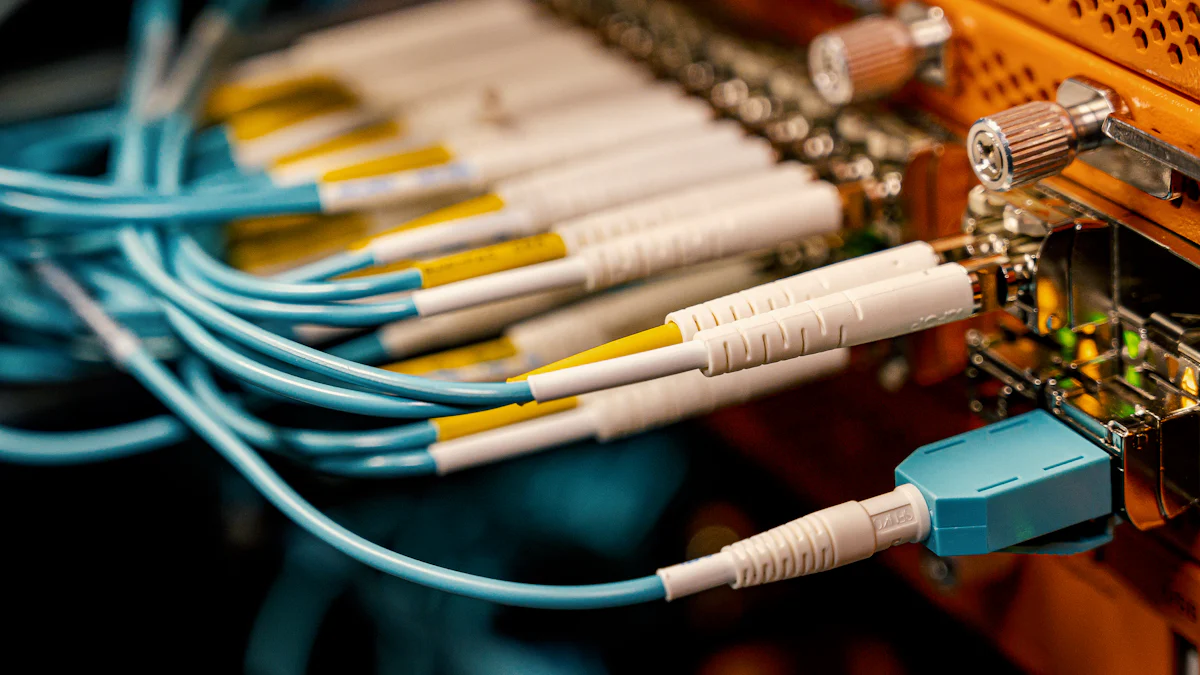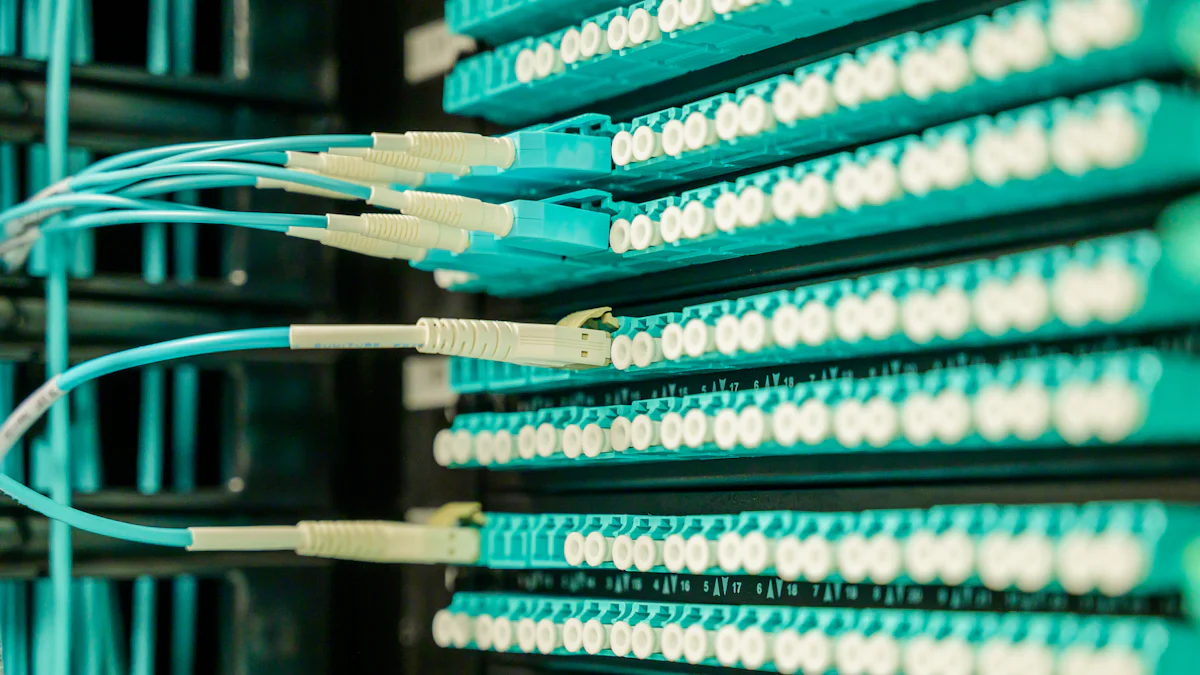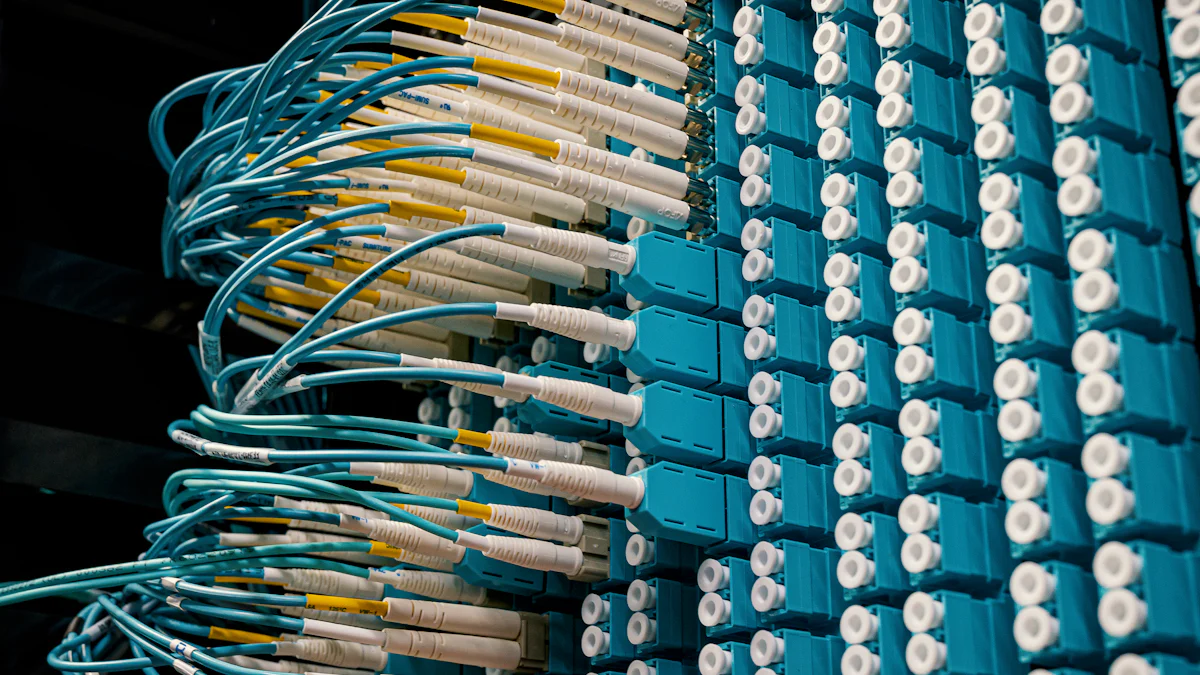How to Select the Right Fiber Optic Patch Cord for FTTH

Fiber optic patch cords play a crucial role in FTTH installations. These cords ensure high-speed and reliable data transmission, surpassing traditional copper broadband. FTTH, or Fiber to the Home, offers superior speed and reliability compared to coaxial and DSL connections. The technology enables data transmission at much higher rates and remains less susceptible to electromagnetic interference. This blog aims to guide readers in selecting the right fiber optic patch cord singlemode 2core Outdoor fiber patch cord ftth drop patch cable assembly PDL for their specific needs.
Understanding Fiber Optic Patch Cords

What is a Fiber Optic Patch Cord?
Definition and Basic Components
A fiber optic patch cord connects optical devices for data transmission. The cord consists of an optical fiber, connectors, and protective outer layers. The core transmits light signals, while the cladding reflects light back into the core. The buffer coating protects the fiber from physical damage.
Common Uses in FTTH
Fiber optic patch cords are essential in FTTH installations. They link the optical network terminal (ONT) to the home network. This connection ensures high-speed internet access and reliable data transmission. FTTH technology supports activities like streaming, gaming, and video conferencing without interruptions.
Types of Fiber Optic Patch Cords
Single-mode vs. Multi-mode
Single-mode patch cords have a small core size, allowing light to travel straight down the fiber. This design minimizes signal loss and supports long-distance transmission. Multi-mode patch cords have a larger core, enabling multiple light paths. This type suits shorter distances and offers higher bandwidth over short ranges.
Simplex vs. Duplex
Simplex patch cords contain a single fiber strand, suitable for one-way data transmission. Duplex patch cords have two fiber strands, enabling simultaneous two-way communication. Duplex cords are common in FTTH networks, providing efficient data exchange between devices.
Armored vs. Non-armored
Armored patch cords feature a protective metal layer, offering extra durability and resistance to physical damage. These cords are ideal for harsh environments. Non-armored patch cords lack this additional protection but are more flexible and easier to install in controlled settings.
Key Specifications
Connector Types (e.g., SC, LC, ST)
Different connectors suit various applications. SC connectors offer a push-pull design for easy insertion and removal. LC connectors are smaller, saving space in dense installations. ST connectors use a bayonet-style coupling, ensuring secure connections.
Cable Length and Flexibility
Selecting the appropriate cable length is crucial for proper connectivity. Measure the distance between devices to avoid excess slack or tension. Flexible cables simplify installation in tight spaces and reduce the risk of damage from bending.
Insertion Loss and Return Loss
Insertion loss measures the signal reduction when light passes through the connector. Lower insertion loss indicates better performance. Return loss quantifies the amount of light reflected back into the fiber. Higher return loss values signify less signal reflection and improved efficiency.
Criteria for Selecting the Right Patch Cord
Application Requirements
Bandwidth Needs
Bandwidth needs determine the type of fiber optic patch cord required. High-bandwidth applications, such as streaming and gaming, demand a fiber optic patch cord singlemode 2core Outdoor fiber patch cord ftth drop patch cable assembly PDL. Single-mode fibers support higher bandwidth over longer distances. Multi-mode fibers suit lower bandwidth needs and shorter distances.
Distance Considerations
Distance considerations play a crucial role in selecting the right patch cord. Single-mode fibers excel in long-distance data transmission due to minimal signal loss. Multi-mode fibers work best for short-range connections. Measure the distance between devices to choose the appropriate fiber optic patch cord singlemode 2core Outdoor fiber patch cord ftth drop patch cable assembly PDL.
Environmental Factors
Indoor vs. Outdoor Use
Environmental factors influence the choice of patch cords. Indoor environments require non-armored patch cords for flexibility and ease of installation. Outdoor environments demand armored patch cords for durability and resistance to physical damage. A fiber optic patch cord singlemode 2core Outdoor fiber patch cord ftth drop patch cable assembly PDL suits outdoor installations.
Temperature and Humidity Resistance
Temperature and humidity resistance are critical for reliable performance. Outdoor installations face varying temperatures and humidity levels. Choose a fiber optic patch cord singlemode 2core Outdoor fiber patch cord ftth drop patch cable assembly PDL with high resistance to these factors. Indoor installations benefit from non-armored patch cords with standard temperature and humidity tolerance.
Compatibility
Matching with Existing Equipment
Compatibility ensures seamless integration with existing equipment. Verify connector types to match the devices. SC, LC, and ST connectors are common options. Ensure the fiber optic patch cord singlemode 2core Outdoor fiber patch cord ftth drop patch cable assembly PDL matches the network's specifications.
Future-Proofing Considerations
Future-proofing considerations help accommodate technological advancements. Select a fiber optic patch cord singlemode 2core Outdoor fiber patch cord ftth drop patch cable assembly PDL that supports future upgrades. Single-mode fibers offer higher bandwidth and longer distances, making them ideal for future-proofing FTTH networks.
Practical Tips for Installation and Maintenance

Installation Best Practices
Proper Handling and Storage
Proper handling and storage of fiber optic patch cords ensure longevity and optimal performance. Always store the fiber optic patch cord singlemode 2core Outdoor fiber patch cord ftth drop patch cable assembly PDL in a clean, dry environment. Use protective covers on connectors to prevent dust and debris from contaminating the fiber ends. Avoid exposing the cords to extreme temperatures or direct sunlight during storage.
Avoiding Physical Stress and Bending
Physical stress and bending can damage the fiber optic patch cord singlemode 2core Outdoor fiber patch cord ftth drop patch cable assembly PDL. Ensure that the installation path is free from sharp bends and kinks. Use cable management tools like clips and ties to secure the cords without applying excessive force. Maintain a minimum bend radius as specified by the manufacturer to prevent signal loss and physical damage.
Maintenance Guidelines
Regular Inspection and Cleaning
Regular inspection and cleaning are crucial for maintaining the performance of the fiber optic patch cord singlemode 2core Outdoor fiber patch cord ftth drop patch cable assembly PDL. Inspect the connectors and cables for signs of wear, damage, or contamination. Use specialized fiber optic cleaning tools and solutions to remove dust and debris from the connectors. Clean the connectors before each connection to ensure optimal signal transmission.
Troubleshooting Common Issues
Troubleshooting common issues helps maintain the reliability of the fiber optic patch cord singlemode 2core Outdoor fiber patch cord ftth drop patch cable assembly PDL. Identify and address problems such as signal loss, connector damage, or physical wear. Use an optical time-domain reflectometer (OTDR) to locate faults within the fiber. Replace damaged connectors or cables promptly to prevent further issues.
Selecting the right fiber optic patch cord for FTTH installations involves understanding various factors. Key points include recognizing the differences between single-mode and multi-mode fibers, choosing appropriate connector types, and considering environmental conditions. Making an informed choice ensures optimal performance and longevity of the network. Consulting with professionals can provide additional insights and guidance. Proper selection and maintenance of fiber optic patch cords contribute to reliable and high-speed data transmission in FTTH networks.
See Also
Choosing the Perfect Custom Duplex OM1 Multimode Fiber Cable
Discovering 1FO SM G657.A2 FastConnect Flat Drop Cable for FTTH
Mastering Fiber Optic Communication: Nylon Cable Application for FTTR
Improving Indoor Connectivity with Invisible FTTR Fiber Cables


